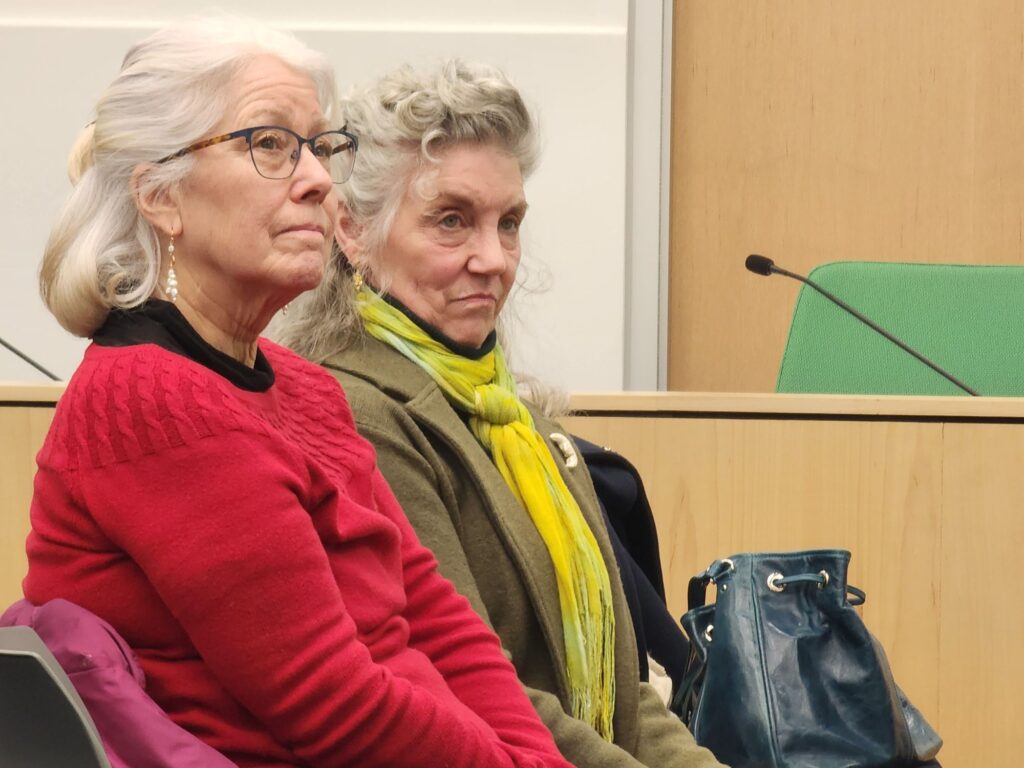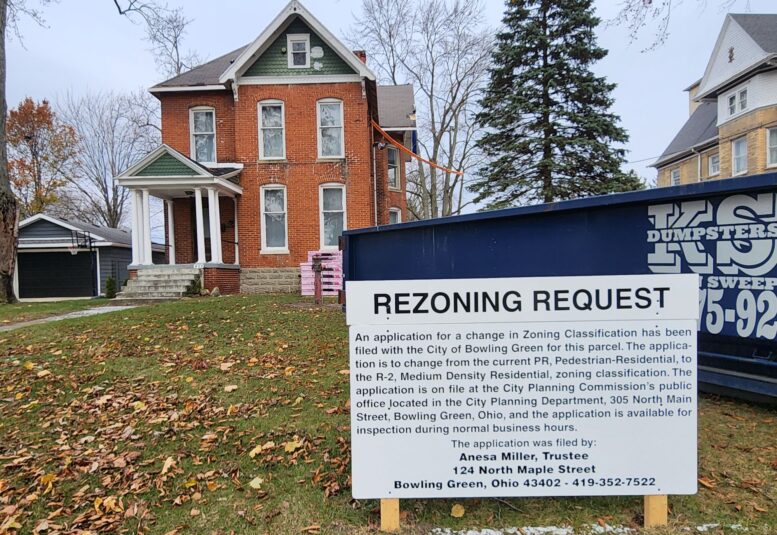By JAN McLAUGHLIN
BG Independent News
Bowling Green Planning Commission on Wednesday weighed the value of preserving one of the oldest buildings on West Wooster Street against preserving a zoning code petitioned for by 650 citizens wanting to prevent more rental properties in their neighborhoods.
Saving the old building from being bulldozed won.
After two hours of listening to pros and cons, the planning commission voted 4-2 to recommend the property at 416 W. Wooster St. be changed from Pedestrian-Residential zoning to R-2 Medium Density zoning.
That change will allow the building, owned by Anesa Miller, to be turned into a duplex.
Voting in favor were Bob McOmber, Judy Ennis, Joe Phillips and Mark Remeis. Voting against were Julie Broadwell and Erica Sleek.
Bowling Green City Council will make the final ruling on the request.
McOmber noted the “reasonable arguments” on both sides of the issue – those wanting to save the structure that was once a hospital, and those worried that the zoning change will open the floodgates for others who want to turn their older homes into duplexes in the historic neighborhood.
But many of those speaking at the meeting said if the zoning was not changed, the fate of the old home would likely be demolition.
The building has a storied past.
Bowling Green physician and pharmacist Dr. Andrew J. Manville built the red brick building as his family home in the 1860s or 1870s. As was customary in that era, Manville saw patients in a specially equipped part of the house.
Later, the building was popularly called the “Old Hospital,” and historically has been known as Community Hospital. It served as the main medical center of Wood County from 1932 to 1951. Many residents still living in Northwest Ohio were born there.
By 1961 the hospital had become the Community Nursing Home, which became Adams Manor Nursing Home in 1965 and the Wooster Manor Nursing Home in 1984. In 1993, the nursing home closed, and the building has been vacant since then.

Miller purchased the property in 2023 hoping to donate it to a non-profit organization willing to renovate it for a public purpose. However, she was unable to find any organization that could take on the expense, so she began exploring possibilities of saving the historic site by renovating the building as a two-family rental.
“My family has urged me from the beginning to demolish the structure,” she said, voicing her commitment to saving the site.
Bowling Green Planning Director Heather Sayler recommended the zoning change be approved, based on the site meeting land use planning goals such as creating more housing, offering a variety of housing types, saving an historic structure, and improving the neighborhood. Sayer also suggested that the property owner be required to first apply for Historic District Overlay designation, which helps preserve historic structures.
But some neighbors questioned the precedent set if the city approves the change. City Council could be hard pressed to turn down similar requests from owners noting the hardships of maintaining old buildings.
The zoning request is problematic since it would require the city to change the zoning for the property from the newly adopted Pedestrian Residential zoning. At the insistence of citizens wanting to protect the neighborhoods and older housing in the blocks surrounding downtown, this zoning does not allow duplexes.
Those provisions came about after more than 650 people signed a petition and convinced City Council to change the zoning code.
Miller herself spoke out at council meetings against duplexes in older neighborhoods that are already populated with a lot of rental housing. “We don’t want more duplexes than we already have,” she said at a meeting in 2023.
During a zoning meeting in the fall of 2022, Miller talked about her concerns that more owner-occupied homes will become rentals. “I do see some deterioration in my neighborhood,” as more houses transition to rental properties, she said.
However, that was before she realized that no nonprofit groups were interested in the site, and that the restoration would be too expensive to turn it into a single-family home.
“That was simply not economically feasible,” said attorney Tom Vogtsberger, who is representing Miller.
Miller’s interest, he said, is to preserve a valuable piece of Bowling Green’s history.
“There’s no profit in this for her,” Vogtsberger said. “She intends on a responsible restoration.”
“West Wooster is stunning,” he added. And it will be even better if this property is saved. “Our community as a whole will be a better place.”
Sean Brennan, the project’s construction manager, talked about Miller’s dedication to doing the restoration right.
“She’s intent on saving this structure,” he said. “It’s a good cause.”
The expenses are great, with the vacant structure having no plumbing, no heating, no mechanicals, and a great deal of water damage, Brennan said.
Brett Gillespie, a roofing contractor, put a new roof on the building last fall, and told of Miller’s attention to maintaining historic details.
Attorney Staten Middleton also talked of Miller’s desire to preserve history.
“I think Anesa should be commended,” he said.
But Rose Drain suggested that the planning commission stick to the hard-fought Pedestrian-Residential zoning that does not allow duplexes. The older neighborhoods surrounding the downtown are “already dense,” Drain said, reminding of the citizen petitions.
“That was a very intensive effort by a lot of people in the city,” she said. “This case is an important opportunity to uphold the integrity of that law.”
Drain recommended that city officials instead amend the zoning code to make exceptions for historic structures, and require the property owners to get Historic District Overlay designations first.
“We are not convinced that this spot zoning will not be followed by more requests for spot zoning,” she said.
David Drain pointed out that two-thirds of the housing in Bowling Green is rental units. Many other neighborhoods are already zoned for mixed use housing, and citizens pushed for PR zoned areas to be safe from “nightmare rentals.”
He asked that the planning commission and council not “denigrate” the hard-fought zoning code.
Spot zoning can have a domino effect, David Drain said. When the next person with a historic home makes a similar request, “how are you going to say no? This is a precedent, and it’s not a good precedent.”
Vogtsberger said at the meeting that Miller’s property is “unique and distinct” and “not precedent setting.”
But Erin Gallagher, who lives in the home just to the west of Miller’s property, disagreed. The reasons used by Miller to seek a zoning change could open the floodgates, Gallagher said.
“That could be applied to any house on Wooster Street, including mine,” she said.
Gallagher voiced concerns about her property values, and said she filed a complaint with the Wood County Health Department about termites at 416 W. Wooster St.
She asked the planning commission to not “rubberstamp” the request.
McOmber objected to the “rubberstamp” term, and said the planning commission had studied a great deal of information from Sayler on the zoning request, and was listening to all the public comments Wednesday evening.
Vassiliki Leontis talked about the time and effort citizens put into bringing about changes to the Pedestrian Residential zoning.
“A lot of people will not want to see changes,” she said.
Suzanne Midden was one of those people pushing to keep duplexes out of the older neighborhoods. However, on Wednesday, she said she was torn.
“I feel really conflicted,” she said. “I’ve been watching that hospital for a long time,” hoping it wouldn’t collapse. “I’m glad to see someone do something about it.”
Four of the planning commission members agreed.
“It really comes down to – are we improving the integrity of a neighborhood?” Remeis said.
“Nobody else was lined up to do it,” Phillips said.
But Broadwell, who lives on the east side of BG in a home that was previously a duplex, said she was sensitive to the issue of houses being chopped up for rentals. Broadwell said she respects the citizen effort to not allow duplexes in some areas.
Sleek also questioned the request for a zoning change.
“If we say yes, why did we spend all those years putting together the zoning code?” Sleek asked.





